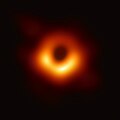

In astrophysics, spaghettification, [1] or noodle effect [2] is the vertical stretching and horizontal compression of objects into long thin shapes in a very strong, non-homogeneous gravitational field. The term was popularized by Stephen Hawking who described the flight of a fictional astronaut who, passing within a black hole's event horizon, is "stretched like spaghetti". [3] [4] It is caused by extreme tidal forces. In the most extreme cases, near a black hole, the stretching and compression are so powerful that no object can resist it. Within a small region, the horizontal compression balances the vertical stretching so that a small object being spaghettified experiences no net change in volume. If one were to fall into a black hole feet first, the gravity at their feet would be much stronger than at their head, causing the person to be vertically stretched. Along with that, the right side of the body will be pulled to the left, and the left side of the body will be pulled to the right, horizontally compressing the person. [5]




